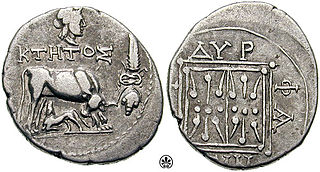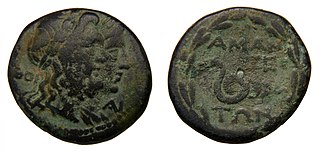Taulantii or Taulantians were an Illyrian people that lived on the Adriatic coast of southern Illyria. They dominated at various times much of the plain between the rivers Drin (Drilon) and Vjosa (Aoös). Their central area was the hinterland of Epidamnos-Dyrrhachion, corresponding to present-day Tirana and the region between the valleys of Mat and Shkumbin (Genusus). The Taulantii are among the oldest attested Illyrian peoples, who established a powerful kingdom in southern Illyria. They are among the peoples who most marked Illyrian history, and thus found their place in the numerous works of historians in classical antiquity.

Apollonia was an Ancient Greek trade colony which developed into an independent polis, and later a Roman city, in southern Illyria. It was located on the right bank of the Aoös/Vjosë river, approximately 10 km from the eastern coast of the Adriatic Sea. Its ruins are situated in the county of Fier, close to the village of Pojan, in Albania.

The Chaonians were an ancient Greek people that inhabited the historical region of Epirus which today is part of northwestern Greece and southern Albania. Together with the Molossians and the Thesprotians, they formed the main tribes of the northwestern Greek group. In historical times on their southern frontier lay the Epirote kingdom of the Molossians, to their southwest stood the kingdom of the Thesprotians, and to their north the Illyrians. By the 5th century BC, they had conquered and combined to a large degree with the neighboring Thesprotians and Molossians. The Chaonians were part of the Epirote League until 170 BC when their territory was annexed by the Roman Republic.

Byllis or Bullis or Boullis (Βουλλίς) was an ancient city and the chief settlement of the Illyrian tribe of the Bylliones, traditionally located in southern Illyria. In Hellenistic times the city was either part of Illyria or Epirus. In Roman times it was included within Epirus Nova, in the province of Macedonia. The remains of Byllis are situated north-east of Vlorë, 25 kilometers from the sea in Hekal, Fier County, Albania. Byllis was designated as an archaeological park on 7 April 2003 by the government of Albania.

Amantia was an ancient city and the main settlement of the Amantes, traditionally located in southern Illyria in classical antiquity. In Hellenistic times the city was either part of Illyria or Epirus. In Roman times it was included within Epirus Nova, in the province of Macedonia. The site has been identified with the village of Ploçë, Vlorë County, Albania. Amantia was designated as an archaeological park on 7 April 2003 by the government of Albania.
Dimale or Dimallum was a town in southern Illyria in classical antiquity which was situated in the vicinity or within the territory of the Parthini, an Illyrian tribe. It was built on a hill of 450 m above sea level, in the hinterland of Apollonia, about 30 km from the eastern coast of the Adriatic. It is located in today Krotinë, Berat County, Albania.
The Parthini, Partini or Partheni were an Illyrian tribe that lived in the inlands of southern Illyria. They likely were located in the Shkumbin valley controlling the important route between the Adriatic Sea and Macedonia, which corresponded to the Via Egnatia of Roman times. Consequently, their neighbours to the west were the Taulantii and to the east the Dassaretii in the region of Lychnidus.

Monounios or Monunius was an Illyrian king who reigned in southern Illyria, in the territory of the Taulantii, around the hinterland of Dyrrhachion and Apollonia. He is the first known Illyrian king to have struck his own silver coins, which were minted in Dyrrhachion. The fact that Monounios' coins were struck in the city mint of Dyrrhachion stresses that he exercised to some extent his authority over the city, as did his successor and probably son Mytilos later.
Thronion was an Ancient Greek city on the Illyrian coast, in the Bay of Vlorë on the southern Adriatic Sea. Although the earliest contacts appear to have been more pre-colonial activity rather than permanent settlement, an ancient, still archaeologically unproven tradition claims that the city was founded as a Locrian–Euboean colony on the fringes of the territory of the Amantes. Thronion was located to the south of the territory of Apollonia and in front of the Acroceraunian Mountains, the natural boundary between ancient Epirus and Illyria. Thronion was conquered by nearby Apollonia before 460 BCE.

Oricum was a harbor on the Illyrian coast that developed in an Ancient Greek polis at the south end of the Bay of Vlorë on the southern Adriatic coast. It was located at the foot of the Akrokeraunian Mountains, the natural border between ancient Epirus and Illyria. Oricum later became an important Roman city between the provinces of Epirus Vetus and Epirus Nova in Macedonia. It is now an archaeological park of Albania, near modern Orikum, Vlorë County. Oricum holds such a strategic geographical position that the area has been in continuous usage as a naval base from antiquity to the present-days.

The Illyrian Kingdom was an Illyrian political entity that existed on the western part of the Balkan Peninsula in ancient times. Regardless of the number of the alternately ruling dynasties, of their tribal affiliation, and of the actual extension of their kingdom, it represented an alliance of Illyrian tribes that united under the rulership of a single leader, expressly referred to as "King of the Illyrians" in ancient historical records.
The Dassaretii were an Illyrian people that lived in the inlands of southern Illyria, between present-day south-eastern Albania and south-western North Macedonia. Their territory included the entire region between the rivers Asamus and Eordaicus, the plateau of Korça locked by the fortress of Pelion and, towards the north it extended to Lake Lychnidus up to the Black Drin. They were directly in contact with the regions of Orestis and Lynkestis of Upper Macedonia. Their chief city was Lychnidos, located on the edge of the lake of the same name. One of the most important settlements in their territory was established at Selcë e Poshtme near the western shore of Lake Lychnidus, where the Illyrian Royal Tombs were built.

Nikaia was a settlement of the koinon of the Bylliones, an Illyrian tribe that through contact with their Ancient Greek neighbours became bilingual. The tribe was found in southern Illyria.
Atintanes or Atintanians was an ancient tribe that dwelled in the borderlands between Epirus and Illyria, in an inland region which was called Atintania. They have been described as either an Epirote tribe that belonged to the northwestern Greek group, or as an Illyrian tribe. They were occasionally subordinate to the Molossians.

Illyrian coinage which began in the 6th century BC continued up to the 1st century of Roman rule. It was the southern Illyrians who minted the first coins followed by the northern Illyrian during the Roman era. Illyrian coins have also been found in other areas apart from Illyria, such ancient Macedonia, Italy, Greece, Asia Minor and Egypt.

The Amantes were an ancient tribe located in the inland area of the Bay of Vlora north of the Ceraunian Mountains and south of Apollonia, in southern Illyria near the boundary with Epirus, nowadays modern Albania. A site of their location has been identified with the archaeological settlement of Amantia, placed above the river Vjosë/Aoos. Amantia is considered to have been their main settlement. The Amantes also inhabited in the area of an ancient sanctuary of the eternal fire called Nymphaion.
The Balaites were an ancient tribe in southern Illyria, modern-day Albania. The tribe is known from a number of Greek inscriptions, otherwise unmentioned among ancient written sources.
Nymphaion was the name given to the ancient sanctuary of the "eternal fire" located in southern Illyria, notably near Apollonia, in modern-day Albania. The location also featured bitumen mines, which, still functioning today, have held a crucial role throughout the history of the region.

Illyrian education is a term in the field of the history of education and pedagogical thought that denotes the totality of forms, organizations and educational institutions in the Illyria and among Illyrians. In the early periods, the education in Illyria and among the Illyrians was under the influence of Greek education, while later it was under the influence of Roman culture. Based on the latest scientific research and discoveries in various aspects of Illyrology: historical, archeological, epigraphic, linguistic, paleographic, etc., it has become possible to better summarize the Illyrian educational system. Illyrian education stretches over a period of time between the 8th century BCE, when the Illyrian culture began to flourish, and the 7th century CE, when the Illyrians are last mentioned in historical sources. In general, it can be said that education among the Illyrians was developed starting from a level of family and informal education towards an organized, institutional, and formal educational system.















